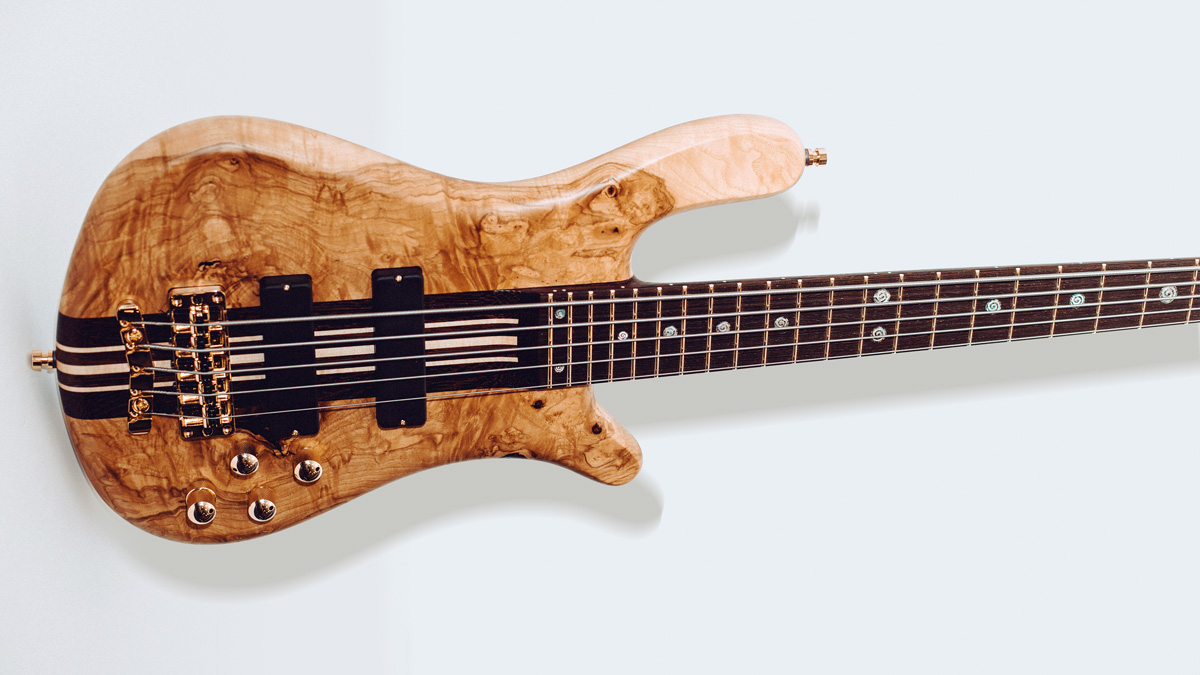MusicRadar Verdict
A great example of the craftsmanship and quality on offer from Warwick.
Pros
- +
Seriously impressive on all fronts, great visuals and powerful, woody tones.
Cons
- -
Hefty pricetag.
MusicRadar's got your back
We’ve reviewed many limited-edition Warwick instruments over the years, and their eye-catching nature never fails to impress.
This particular model harks back to the late 80s and early 90s when the Streamer Stage 1 seemed to be everywhere, especially among the rock community. Their ingredients may be on the expensive side, but the recipe remains the same - with a tweak here and there - so when we were presented with this bass for review at LBGS 2018, naturally we were keen to give it a thorough going-over. The Streamer is still widely available, of course, but this variant is a little special - as we’ll see.
Build
Every Warwick Limited Edition bass has plenty of luxurious touches, and this one is no exception. The curvaceous, sculpted body shape, made from European swamp ash with a burl top, is everything you would expect from a top-end model, with extensive cutaways that offer great access to the upper regions of the 24-fret wenge fingerboard.
The level of finishing across the whole instrument is first-class - it’s a ‘Masterbuilt’ instrument after all - and there are no sharp fret ends anywhere across either side of the neck. The matching headstock facing works well in conjunction with the dark, richly coloured timbers used throughout; additionally, the dark and light woods are complemented by the gold hardware and a satin finish.
The shallow D-shaped neck profile, 18mm string spacing at the two- piece bridge unit and excellent setup make for a rewarding playing experience. As a five-string instrument, the neck profile works well in tandem with the broad fingerboard and, with a nut width of 46mm, comfort is the order of the day. The seven-piece wenge and maple laminate through-neck give the bass plenty of rigidity, and looks great.
Although there is some headstock bias, the bass sits perfectly against the player when placed on a strap and at 4.2 kilos it is quite manageable as far as five-string basses go. Abalone and pearl spiral position markers adorn the wenge fingerboard with white dot markers featuring along the side of the neck. All of the hardware is securely attached and solidly manufactured, and the bass has a reassuring feel to it, indicating that a lot of time and effort has gone into its construction.
Sounds
The Aguilar pickups and preamp are a radical change from the MEC package we’d usually expect to see on a Warwick, but a change is as good as a rest, they say, and in this instance the combination is a great success. Acoustically, the bass feels vibrant and resonant with a strong sustain and clear fundamental tone. In the past, we have experienced several Warwick instruments that sounded soft, almost ‘spongy’, both unplugged and amplified, but this is certainly not the case with this bass. Despite being a through-neck, the warmth of the timbers are matched with a noticeable ‘bounce’ that can be felt through the body.
Want all the hottest music and gear news, reviews, deals, features and more, direct to your inbox? Sign up here.
Plugged in, the tonal palette on offer is very broad. The Aguilar DCB-D2 soapbar pickups do a fine job, providing punch and clarity combined with a powerful, forthright display across all five strings, while the string volume is fairly consistent across the whole neck. The low B-string is particularly well focused and sits very well with the overall sonic performance, enhanced by the mid-EQ. With the Aguilar OBP-3 preamp, two mid-frequency settings (400/800Hz) can be cut or boosted using the push/pull operation on the mid control. For more power in the low mids, select the 400Hz setting, and if some extra definition and presence are required, select the 800Hz option.
Panning across the pickups highlights a fine assortment of tonal options, while the stacked bass/treble control provides a great depth of tone, allowing you to unleash an arsenal of sounds that will appeal to a broad cross-section of players. Rockers will instantly take to the organic wooden tones, which sound very impressive with fingers, pick or slapping. The percussive tones are very satisfying and stand out without being excessive. Adding bottom end provides a rich warmth that works well with the instrument’s core voice without overloading your signal, but if you like a full-on sound dripping in bass goodness, you can have that too.
We shouldn’t be surprised, but this is a highly impressive instrument all round; in terms of quality, sound and playability it can’t be faulted. However, the major stumbling block is the price. We’re not convinced that many players will stump up £5660, no matter how good it is. It’s a shame, because this is a fabulous bass. Competition is fierce when you enter the boutique world of custom-built bass guitars, but if you have the opportunity to try one of these, do so - you will be amazed.
